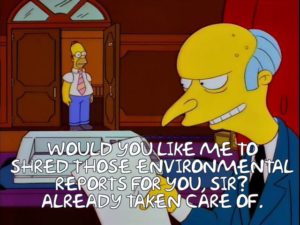Every Environmental Professional can tell some version of this story. It’s a microcosm of environmental protection history and the current Executive Branch’s take on a healthy environment. I can tell you several examples from my own career. The specifics aren’t necessary to understand the point. So let me tell you an environmental tale as old as time.
It starts when an Environmental Professional identifies a problem. For example, lead contamination or a changing climate. The Professional first provides information about the problem: how it can poison you or contaminate waterways, for example. Then he or she offers support and a solution: education, sampling, engineering, remediation, etc. All of this is the Professional doing his or her job. So far, so good.
Here come the hurdles. The decision maker and/or the money to implement the solution is outside the Environmental Professional’s control. The Professional appreciates and emphasizes the severity of the problem. The authority with the money does not appreciate, care, or prioritize it. Therefore, the problem is not addressed.
Now the people or group impacted by the problem become upset. For example, people working in a building with exposed friable asbestos or people living on a warming planet. They know a hazard has been identified and they know someone has chose not to address it. Then they express their concern to the authority figure or group, often without restraint. The person or group who could have fixed it is now upset that they’ve been called out publicly. They’re sometimes embarrassed that they’ve been accused of not doing their job.
That authority then turns their rage toward the Environmental Professional. This is their attempt to scapegoat or pass the responsibility. Too late. The Professional does one or more of the following: offers assistance on how to fix it, rolls their eyes, thinks “I told you so”, or is fuming that you should have listened in the first place. They’re ready to BLEVE. In some cases, the authority is concerned there could be more outrage. It’s not a surprise when they try to hide or bury the information about the hazard or toxins.
Fun job, isn’t it?
You can find countless arguments and articles about how the EPA or other science related agencies, “need to do more.” More to inform people about contamination in their community, more to protect clean drinking water, more to combat climate change, more to clean up toxic mine water, etc. The EPA would love to do all these things and more. They don’t have the money or the authority. Now the Executive Branch wants to cut their funding and back out of the Paris Climate Agreement at a time when the people of the United States clearly want a healthier environment. Don’t hide from the problem because you don’t understand or fear the solution.
Environmental professionals and agencies know the problems and how to fix it. Let’s give them the power to do so.
Have you experienced a similar story in the environmental field? What about in another field? I’m sure you have.

